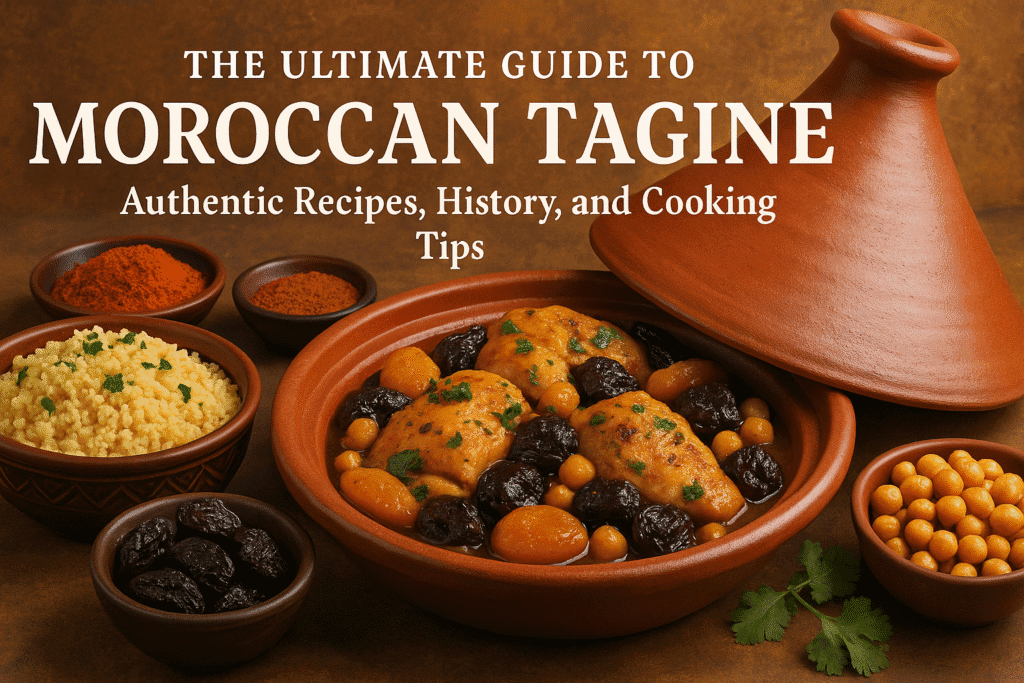Published on QuickEatsHub.com | Reading Time: 12 minutes
Moroccan tagine is more than just a dish—it’s a culinary journey that transports you to the bustling souks of Marrakech and the aromatic kitchens of traditional Moroccan homes. This slow-cooked, flavor-packed stew has captured hearts worldwide with its perfect balance of sweet and savory ingredients, warming spices, and tender textures.
Whether you’re a seasoned home cook or just beginning your culinary adventure, this comprehensive guide will teach you everything you need to know about making authentic Moroccan tagine at home.
Table of Contents

What is Moroccan Tagine?
Tagine (pronounced ta-ZHEEN) refers both to the distinctive cone-shaped clay cooking vessel and the aromatic stew cooked within it. This traditional North African dish has been a cornerstone of Moroccan cuisine for centuries, representing the perfect marriage of Berber, Arab, and Mediterranean culinary influences.
The unique shape of the tagine pot creates a natural steam circulation system. As steam rises from the cooking food, it condenses on the cool, sloped sides of the conical lid and drips back down, keeping the ingredients moist and concentrating the flavors without requiring much liquid.
The Cultural Significance of Tagine
In Moroccan culture, preparing tagine is often a communal activity that brings families together. The slow cooking process encourages patience and mindfulness, while the sharing of the finished dish from a single pot symbolizes unity and hospitality—core values in Moroccan society.
Essential Ingredients for Authentic Moroccan Tagine
The Spice Foundation
The soul of any great tagine lies in its spice blend. Here are the essential spices that create the characteristic Moroccan flavor profile:
Primary Spices:
- Ras el Hanout: A complex spice blend containing up to 30 different spices
- Ground Ginger: Adds warmth and subtle heat
- Ground Cinnamon: Provides sweetness and depth
- Ground Cumin: Earthy and slightly bitter notes
- Ground Coriander: Fresh, citrusy undertones
- Paprika: Mild heat and vibrant color
- Saffron: Luxury spice adding golden color and distinctive aroma
Supporting Spices:
- Turmeric for color and mild flavor
- Cayenne pepper for heat (optional)
- Ground cloves for warmth
- Ground cardamom for floral notes
Protein Options
Traditional tagine recipes feature various proteins:
- Chicken: Most popular choice, preferably bone-in thighs for tenderness
- Lamb: Traditional option offering rich, gamey flavors
- Beef: Usually chuck roast or other slow-cooking cuts
- Fish: Coastal variations using firm white fish
- Vegetarian: Featuring chickpeas, lentils, and seasonal vegetables
Signature Ingredients
What makes tagine uniquely Moroccan are these distinctive ingredients:
- Preserved Lemons: Adds tangy, salty brightness
- Dried Fruits: Apricots, prunes, or dates for natural sweetness
- Olives: Usually green, providing briny depth
- Fresh Herbs: Cilantro and parsley for freshness
- Honey or Sugar: Balances the spices and acids
Classic Moroccan Chicken Tagine Recipe
Serves 6-8 people | Prep Time: 20 minutes | Cook Time: 1 hour 30 minutes
Ingredients
For the Chicken:
- 3 lbs bone-in, skin-on chicken thighs and drumsticks
- 2 teaspoons kosher salt
- 1 teaspoon black pepper
- 2 tablespoons olive oil
For the Spice Blend:
- 2 teaspoons ground ginger
- 1 teaspoon ground cinnamon
- 1 teaspoon ground cumin
- 1 teaspoon ground coriander
- 1 teaspoon paprika
- ½ teaspoon turmeric
- ¼ teaspoon cayenne pepper
- Pinch of saffron threads
For the Tagine:
- 2 large onions, thinly sliced
- 4 cloves garlic, minced
- 1 cup chicken broth
- ½ cup dried apricots, halved
- ½ cup green olives, pitted
- 2 preserved lemons, quartered (or zest of 2 lemons)
- 2 tablespoons honey
- ¼ cup fresh cilantro, chopped
- ¼ cup fresh parsley, chopped
Step-by-Step Instructions
Step 1: Prepare the Chicken
- Pat chicken pieces dry with paper towels
- Season generously with salt and pepper on both sides
- Let rest at room temperature for 15 minutes
Step 2: Create the Spice Blend
- Combine all spices in a small bowl
- Mix thoroughly and set aside
- If using saffron, steep in 2 tablespoons warm water
Step 3: Brown the Chicken
- Heat olive oil in your tagine pot or Dutch oven over medium-high heat
- Brown chicken pieces skin-side down for 5-6 minutes until golden
- Flip and brown the other side for 4-5 minutes
- Remove chicken and set aside (remove skin if desired)
Step 4: Build the Flavor Base
- In the same pot, add sliced onions
- Cook for 8-10 minutes until softened and lightly caramelized
- Add minced garlic and spice blend
- Cook for 1 minute until fragrant
Step 5: Simmer the Tagine
- Return chicken to the pot
- Add chicken broth, dried apricots, and honey
- Bring to a gentle simmer
- Cover and cook for 45 minutes
Step 6: Final Touches
- Add olives and preserved lemons
- Continue cooking for 15 minutes until chicken is tender
- Stir in fresh herbs just before serving
- Taste and adjust seasoning
Serving Suggestions
Serve your chicken tagine over:
- Fluffy Couscous: The traditional accompaniment
- Moroccan Rice: Flavored with cinnamon and almonds
- Crusty Bread: For soaking up the delicious sauce
- Quinoa: A modern, protein-rich alternative
Popular Tagine Variations
Moroccan Vegetable Tagine
Perfect for vegetarians and vegans, this colorful variation features:
- Seasonal root vegetables (carrots, potatoes, parsnips)
- Chickpeas for protein
- Dried fruits for sweetness
- Fresh herbs and spices
- Vegetable broth instead of chicken broth
Lamb and Prune Tagine
A classic sweet-and-savory combination featuring:
- Tender lamb shoulder or leg
- Sweet prunes and apricots
- Caramelized onions
- Warm spices with extra cinnamon
- Toasted almonds for garnish
Fish Tagine (Tagine Hout)
Coastal Moroccan specialty including:
- Firm white fish (cod, halibut, or sea bass)
- Preserved lemons and olives
- Fresh tomatoes
- Potatoes and carrots
- Chermoula spice paste
Essential Equipment and Cooking Tips
Do You Need a Traditional Tagine Pot?
While a traditional clay tagine pot creates the most authentic results, you can achieve excellent results using:
- Dutch Oven: Heavy-bottomed with tight-fitting lid
- Cast Iron Braiser: Wide, shallow design ideal for browning
- Slow Cooker: For convenience, though less browning capability
- Heavy-Bottomed Pot: Any pot with a tight-fitting lid works
Pro Tips for Perfect Tagine
- Low and Slow: Never rush the cooking process
- Layer Flavors: Brown proteins and build your spice base
- Balance is Key: Taste and adjust sweet, salty, and acidic elements
- Fresh Herbs Last: Add delicate herbs just before serving
- Rest Before Serving: Let tagine rest 10 minutes for flavors to meld
Health Benefits of Moroccan Tagine
Nutritional Advantages
Tagine offers numerous health benefits:
- High in Protein: Especially chicken and lamb versions
- Rich in Antioxidants: From spices like turmeric and ginger
- Healthy Fats: From olive oil and preserved lemons
- Fiber-Rich: When served with whole grain couscous
- Low Sodium: When made without processed ingredients
Anti-Inflammatory Spices
Many tagine spices provide health benefits:
- Ginger: Aids digestion and reduces inflammation
- Turmeric: Contains curcumin, a powerful anti-inflammatory
- Cinnamon: Helps regulate blood sugar
- Cumin: Rich in iron and may aid digestion
Make-Ahead and Storage Tips
Meal Prep Friendly
Tagine is excellent for meal preparation:
- Make Ahead: Flavors improve overnight in the refrigerator
- Freezer Friendly: Freeze portions for up to 3 months
- Reheat Gently: Use low heat to preserve texture
- Storage: Keeps 3-4 days in the refrigerator
Batch Cooking Suggestions
Double your recipe and:
- Freeze half for later meals
- Transform leftovers into tagine-spiced grain bowls
- Use as filling for wraps or pita pockets
- Serve over different grains throughout the week
Shopping Guide for Moroccan Ingredients
Where to Find Authentic Ingredients
Middle Eastern Markets: Best selection of spices and preserved lemons Online Retailers: Convenient for hard-to-find items Health Food Stores: Often carry organic spice blends Regular Supermarkets: Increasing selection in international aisles
Essential Pantry Items
Stock your pantry with these tagine essentials:
- Quality olive oil
- Whole spices for grinding fresh
- Dried fruits (apricots, dates, prunes)
- Canned chickpeas
- Preserved lemons (or ingredients to make your own)
- Good-quality honey
Troubleshooting Common Tagine Problems
Too Watery?
- Remove lid and simmer uncovered to reduce liquid
- Add tomato paste for thickening
- Mix cornstarch with cold water and stir in
Too Salty?
- Add honey or sugar to balance
- Include more vegetables to dilute
- Serve with plain couscous or rice
Lacks Flavor?
- Add more spices during cooking
- Finish with fresh lemon juice
- Check that spices are fresh (replace annually)
- Add fresh herbs just before serving
Conclusion: Mastering the Art of Moroccan Tagine
Creating authentic Moroccan tagine at home is a rewarding culinary journey that brings the exotic flavors of North Africa to your kitchen. With patience, quality ingredients, and attention to balancing flavors, you’ll master this ancient cooking technique and create memorable meals for family and friends.
Remember, tagine is as much about the experience as it is about the food. Embrace the slow cooking process, enjoy the aromatic journey, and savor the communal aspect of sharing this traditional dish.
Start with our classic chicken tagine recipe, then experiment with different proteins and vegetables to create your own signature variations. With practice, you’ll develop an intuitive understanding of the spice combinations and cooking techniques that make Moroccan tagine truly special.
Ready to start your tagine adventure? Browse our collection of Moroccan recipes and spice guides for more authentic North African cooking inspiration. Don’t forget to share your tagine creations with us on social media using #QuickEatsHub!
Related Articles:
